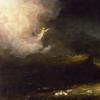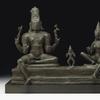Amon Carter Museum of American Art Acquires Masterpiece by Raphaelle Peale in Memory of Ruth Carter Stevenson
- FORT WORTH, Texas
- /
- July 26, 2014
The Amon Carter Museum of American Art has acquired the painting Peaches and Grapes in a Chinese Export Basket (1813) by Raphaelle Peale (1774–1825). The first work by Peale to enter the collection, the still life painting was purchased in memory of the museum’s founder Ruth Carter Stevenson (1913–2013). It was offered in the million-dollar range by Philadelphia dealer Schwarz Gallery at this year's Winter Antiques Show in New York. The painting is on view beginning July 29 in the museum's main gallery.
“Raphaelle Peale is considered the first American still-life artist,” says Andrew J. Walker, director of the Amon Carter. “His paintings established the tradition in this country, and they remain among the most magnificent images of their kind ever created. Adding this superb painting by Peale gives depth to the collection, and it also provides us an opportunity to tell the story of how still life became a respected art form.”
Raised within a large family of talented artists, Raphaelle differentiated himself from his younger brother Rembrandt (1778–1860) by refraining from the more lucrative career of portraiture. He also distanced himself from his father, Charles Willson Peale (1741–1827), by ignoring his disdain for the genre of still-life painting as an unsuitable pursuit for a professional artist. He did so at a time when the subject was at the bottom on the hierarchy of artistic genres.
“Raphaelle Peale’s work was the foundation for notable American artists such as William Harnett, William McCloskey and John F. Peto, all of whom are represented in the Amon Carter collection,” Walker says.
Peale often found objects for his compositions among the fruits growing at his father’s estate in Philadelphia. Peaches and Grapes in a Chinese Export Basket is one of the artist’s earliest signed and dated pictures. The carefully composed, well-balanced painting displays the artist’s skills at illusionism.
“Peale had the tremendous ability to replicate the uncanny physical presence of three-dimensional objects on a two-dimensional surface,” says Rebecca Lawton, painting and sculpture curator. “The objects depicted in this painting are so visually striking that they evoke our senses of touch, smell and taste. But, this painting, like so many of his works, is far from just an impeccably elegant picture that serves only the senses. It transcends a simple composition and expresses the moral tension between necessity and indulgence. It also reflects the social and cultural aspirations of a young republic after the American Revolution.”
The Amon Carter recently exhibited six paintings by Raphaelle Peale in the Art and Appetite exhibition organized by The Art Institute of Chicago.
“It whetted our appetites, so to speak, for a Peale painting of our own,” says Walker. “In addition to what this new acquisition brings to our collection, it’s also a wonderful tribute to Mrs. Stevenson. She had a special fondness for still-life painting, especially when the subject reflected her other passions, gardening and horticulture. And, like Peale, she was a trailblazer.”
The Amon Carter Museum of American Art is open Tuesday through Saturday from 10 a.m. to 5 p.m., Thursday until 8 p.m. and Sunday from noon to 5 p.m. Admission is always free. More information at www.cartermuseum.org.
About Raphaelle Peale (1774–1825)
Born into an artistic Philadelphia family, Raphaelle was the eldest son of Charles Willson Peale and the nephew of James Peale, both artists. He and his siblings were named after famous Old Master painters. (His brothers were named Rembrandt, Titian and Rubens.) His father was a well-known portrait painter, naturalist and one of revolutionary America’s great cultural leaders.
Academic theory during Raphaelle Peale’s time relegated still life to the bottom of the hierarchy of painting subjects; portraiture was considered more admirable. But Raphaelle ignored its low status and pursued still life, creating some of the most beautiful American paintings of the 19th century.
Raphaelle was steeped in the ideals of the American Revolution. His father served in the war and painted portraits of the era’s great leaders, among them Benjamin Franklin, Thomas Jefferson and George Washington. He expressed the aspirations of the new republic through still life, by creating compositions characterized by crisp forms and balance. Most of his paintings portray food (mainly fruit), crockery and glassware arranged on a plain shelf, parallel to the picture plane.
















